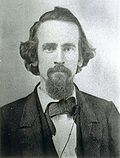

Henry George
The idea of Earth as a ship in space can be traced back to the American social reformer Henry George.1
Writing at a time when land speculation had brought ruin to many, Henry George famously proposed that taxes based only on land valuation would dampen such manias and lead to a more equitable society.

Fuller, ca. 1917
The popularity of the concept of Earth as a spaceship undoubtedly owes much to the efforts of Buckminster Fuller, the author of Operating Manual for Spaceship Earth. In 1965, he said, in an address to the Phi Beta Kappa Society3
By then, however, Fuller had been framing the problem of humanity's future in these terms for some time, during the cruises to Delos hosted by ekistics founder, the urban planner Constantinos Doxiadis.
The term Spaceship Earth was apparently coined by British economist Barbara Ward, an early advocate of sustainable development. Ward, a shipmate of Fuller's on the Delos cruises, credited him with the concept.* The trope was used in a speech she had drafted on the problems of urbanization, delivered before the U.N. Social and Economic Council by her close friend, the American diplomat Adlai Stevenson.4 Ward was the author of a book entitled "Spaceship Earth", first published in 1966.5 The term was soon picked up and promoted by the economist and philosopher Kenneth Boulding, by Robert McNamara (himself a Delos cruise veteran6) in his role at the World Bank,7 and eventually, through the influence of Ray Bradbury, by the Disney corporation.

Barbara Ward
In Spaceship Earth, Ward wrote:

Adlai Stevenson
From Stevenson's speech in Geneva, five days before his death:8

Epcot's Spaceship Earth
The term "Spaceship Earth" was never trademarked. Project Persephone certainly doesn't seek to appropriate it, but at most to re-illuminate it from new angles. However, if there has been any serious contender for appropriation of the term, as reflected in popular usage, it was the Disney corporation, with its Spaceship Earth attraction at Disney World's Epcot.

Disney with von Braun
It is perhaps unfair to call the Disney corporation's use of "Spaceship Earth" a vulgarization of the original concept. Walt Disney's vision for EPCOT - the Experimental Prototype Community of Tomorrow - was derided by some as a "commodified utopia",9 a grandiose reaction both to the problems of success seen in Disneyland's increasingly tawdry commercial periphery and to America's social failures in the mid-1960s. However, in Walt Disney's emphasis on a very dense urban core ringed with a greenbelt, with mass transportation conveniently connecting lower-density housing to the urban core, it's not hard to see that he was concerned with some issues of sustainability. Disney was both a technological innovator and an entertainment entrepreneur. Project Persephone unabashedly embraces both roles, so long as they are "Meeting the SPEC". A Spaceship Earth on which we are all crew, all the time, would be neither necessary nor sufficient. A Spaceship Earth on which most of us are having fun on most days -- a theme park taking itself as its theme -- would clearly be better, as long as it was sustainable. If exploiting space resources is the way to reach that ludotopia, Project Persephone could be a contributor to progress toward the goal.

Ray Bradbury
Disney, at the end of this life, wanted to solve pressing social (and, to some extent, environmental) problems. In Project Persephone's view of Spaceship Earth, Walt Disney might be considered an imperfect model, but still worthy of (posthumous) Honorary Crewmember status. Though Disney probably did not envision enshrining Spaceship Earth at EPCOT (credit for that is due to Ray Bradbury10), if he'd lived to see Earth Day, he might have endorsed the concept.
Notes
* Coinage is disputed. Buckminster Fuller is most frequently credited with coining the term Spaceship Earth. It's been claimed, in a book containing the German translation of Operating Manual for Spaceship Earth (and "other writings") that he began using the term "Spaceship Earth" in 1951.11 However, his first documented use of the trope -- if not of the exact term "Spaceship Earth" -- seems to be in October, 1965, in an address to the Phi Beta Kappa Society.12 Adlai Stevenson had already given his speech at the U.N., in early July; perhaps before that, he'd suggested similar wording to LBJ, for a speech: that Earth was a "space ship spinning through unimaginable distance . . . . we can wreck that ship."13 An ambiguous citation of written credit for the term "Spaceship Earth" being used first by Fuller instead of Ward has been found in the Fuller library.14
1 There may be at least one earlier use, by Nikolai Federov, see p.79, The Russian Cosmists: The Esoteric Futurism of Nikolai Fedorov and His Followers, George M. Young, ISBN-10: 0199892946 ⇑
2 Henry George, Progress and Poverty, Book IV, Ch. 2, 1879 ⇑
3 "Vision 65 Summary Lecture", published in the magazine of the Phi Beta Kappa Society, The American Scholar, Vol. 35, p. 206, 1966 (April); reprinted in Fuller's Utopia or Oblivian ⇑
4 John McCormick, Reclaiming Paradise: The Global Environmental Movement, p.67 http://books.google.com/books?id=xC16yGp9-HUC&pg=PA67&dq=spaceship.earth+barbara.ward ⇑
5 Barbara Ward, Spaceship Earth http://books.google.com/books?id=c7oHPAAACAAJ&dq=barbara.ward+spaceship.earth ⇑
6 Jean Gartlan, Barbara Ward: Her Life and Letters, p.166 http://books.google.com/books?id=2Id7vrJvGWQC&lpg=PA166&dq=buckminster.fuller%20delos%20mcnamara&pg=PA166#v=onepage&q=delos&f=false ⇑
7 Robert Mcnamara, in One Hundred Countries, Two Billion People: The Dimensions of Development, 1973 ⇑
8 Suzanne Mc Intire?, American Heritage Book of Great American Speeches for Young People, p.230 http://books.google.com/books?id=B1XgK1SRqPwC&pg=PA230&dq=%22We+travel+together,+passengers+on+a+little+space+ship%22 ⇑
9 Matthew Arnold, "Walt Disney, EPCOT, the Creation of a Commodified Utopia", https://sites.google.com/site/theoriginalepcot/a-look-back ⇑
10 Robin Miller, "Ray Bradbury - Following his passion to Mars", http://www.raybradbury.com/articles_town_talk.html ⇑
11 Bedienungsanleitung f�r das Raumschiff Erde und andere Schriftenthat, Krauss & Fuller, http://books.google.com/books?id=uZajAQAACAAJ&dq=%22Bedienungsanleitung+fuer+das+Raumschiff+Erde+und+andere+Schriften%22] ⇑
12 http://robertfripp.ca/index.cfm?Fuseaction=ArticleDisplay&ArticleID=524&SectionID=160 ⇑
13 John Bartlow Martin, Adlai Stevenson and the world, http://books.google.com/books?q=spinning.through.unimaginable.distance%20adlai&dq=spinning.through.unimaginable.distancei&hl=en&um=1&ie=UTF-8&sa=N&tab=wp ⇑
14 Chapter 1, "Network Artists as Anticipatory Design Scientists" of Victoria Vesna's dissertation, "Networked Triadic Spaces" ⇑